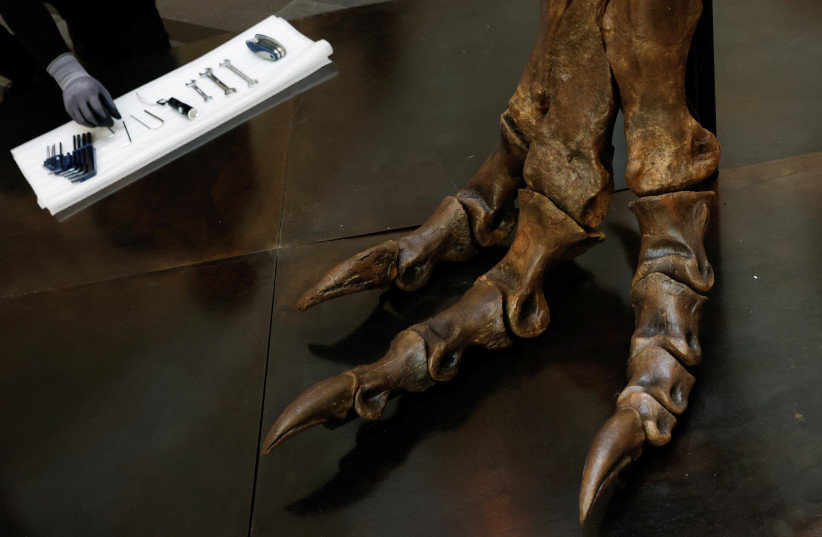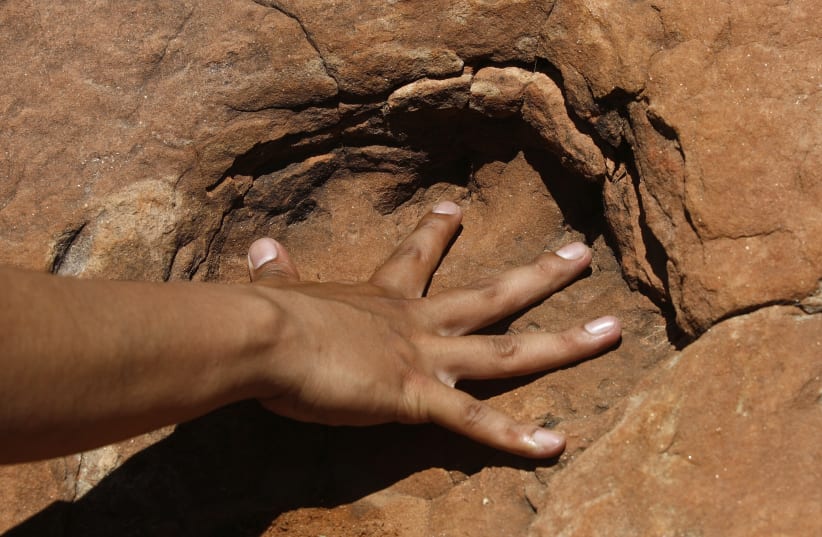A new study suggests that prehistoric humans have found dinosaur footprints meaningful or interesting, CNN reported on Thursday.
According to the report, ancient humans in Brazil carved drawings into the rock next to dinosaur footprints at a site called Serrote do Letreiro in Paraiba on the eastern side of the country. Recent drone field surveys uncovered new carvings showing tracks that belonged to dinosaurs.
Dinosaurs went extinct at the close of the Mesozoic era, which ended approximately 66 million years ago.
The carved drawings were first discovered by scientists in 1975; however, they are only now being interpreted as relating to the footprints.
“People usually think that Indigenous people weren’t aware of their surroundings or didn’t have any kind of scientific spirit or curiosity,” study co-author Leonardo Troiano said.
Troiano, an archaeologist at the Institute of National Historic and Artistic Heritage in Brasilia, further added that that conception is mistaken and that “it’s very clear that they were interested in the footprints.”
Troiano emphasized that while they might not know if these prehistoric humans knew of dinosaurs, they were curious about them and “thought they were meaningful in some way.”
The carved drawings, termed petroglyphs by archeologists, are not the only evidence that supports this theory. There are other examples of art found on rocks in proximity to dinosaur prints. However, CNN reported that the authors of the study said they believe that the association between the footprints and carvings at Serrote do Letreiro is unprecedentedly clear and might have significant implications for paleontology, archaeology, and cultural heritage studies.
Petroglyphs and dinosaur tracks

While the exact age of the petroglyphs remains uncertain, radiocarbon dating of nearby burial sites suggests they could be between 2,620 and 9,400 years old, indicating that the tribes responsible for them lived during this period.
Troiano suggested that the ancient people likely lived in small communities and used natural rocky shelters as homes. He describes the region as similar to the Australian Outback, emphasizing the challenging environmental conditions that ancient artists faced.
"It’s really hot, and there’s no shade, so it’s not easy to stand there and carve the rock. It requires a lot of effort, so when they picked this location, they were being very intentional," Troiano added.
The petroglyphs are in a diverse range of styles, suggesting the involvement of multiple artists. Troiano noted the variety in shapes, with some resembling plants and others featuring geometric forms such as squares, rectangles, and circles adorned with crosses or lines resembling stars.
However, the exact meaning behind these markings remains a mystery. As Troiano states, "They all seem to be abstract, and if they represented something to the people who made them, we don’t know what it is."
In addition to the petroglyphs, the site also contains dinosaur tracks belonging to three types of dinosaurs: theropods, sauropods, and ornithopods. The researchers speculate that the ancient peoples may have mistaken some dinosaur tracks for those of large native birds, such as rheas, due to their similar appearance. However, interpreting sauropod tracks poses greater challenges, given their dissimilarity to any known contemporary animals.
Sacred rituals and dinosaur tracks
Troiano, the lead researcher, suggested that the creation of the petroglyphs might have been embedded in communal rituals, possibly involving the use of psychotropic plants such as jurema, which is still abundant in the region today. He speculates that ancient peoples gathered during communal events and were interested in the meaning of the dinosaur footprints, which they likely identified and incorporated into their artwork intentionally.
Troiano elaborated, stating, “I think rock art creation was embedded in some sort of ritual context: people gathering and creating something, perhaps utilizing some psychotropics. We have a plant called jurema, which is hallucinogenic, and it is still used to this day.” He further added, “We can speculate that people were using it in the past as well because it is so abundant and common in the region. I think they were interested in what the footprints represent, and I suppose they identified them as footprints. They noticed it was not random.”
The unique aspect of the Serrote do Letreiro petroglyphs is their direct association with dinosaur fossil tracks, a phenomenon not observed to the same extent in other locations such as the United States and Poland. Troiano emphasized the importance of intentionality in the placement of the petroglyphs relative to the dinosaur tracks, suggesting that this positioning reflects thoughtfulness on the part of the ancient artists.
Troiano also mentioned that he is working on a follow-up paper that delves deeper into the interpretation and analysis of the petroglyphs, expanding upon the findings of the current study. Reflecting on the significance of the petroglyphs' association with dinosaur tracks, Radosław Palonka, an associate professor of archaeology at the Jagiellonian University in Poland, commented, “The fact that the locations of the rock art panel have been chosen specifically is shown by, among others, the fact that representatives of the communities that created rock paintings or petroglyphs often placed them very close to older images left by other cultures.”
Jan Simek, a distinguished professor of anthropology at the University of Tennessee, Knoxville, emphasized the broader human tendency to tie spiritual beliefs and narratives to unexplained phenomena in the natural world. He compared the Brazilian case to how ancient Greeks and Romans interpreted fossils as evidence of giants and monsters from their mythologies, highlighting the universal human inclination to imbue the environment with spiritual significance.
